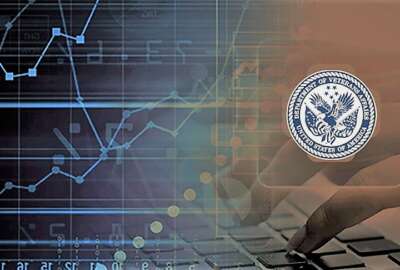

Many agencies are working to improve customer experience. An important element of that is convenience and identification and verification of those accessing digital...
Best listening experience is on Chrome, Firefox or Safari. Subscribe to Federal Drive’s daily audio interviews on Apple Podcasts or PodcastOne.
Sometimes the key to what you want is right under that flowerpot on your windowsill. Many agencies are working to improve customer experience. An important element of that is convenience and identification and verification of those accessing digital services. Now the Veterans Affairs Department has expanded its use of login.gov for that very purpose. The Federal Drive with Tom Temin. gets more now from VA’s digital services expert, John Rahaghi.
Interview transcript:
Tom Temin: Login.gov is not unknown at this point to VA for some of the services offered, tell us the extent until this point of your use of login.gov and what you get out of it.
John Rahaghi: So login.gov is available on va.gov, on MyHealtheVet and on VA’s mobile flagship, and we have plans to further expand and increase the adoption for login.gov. It is a government built and maintained credential driven by human centered design. So it’s been a huge focus on making sure that it’s easy to use. And we know that for our users, they really do want to have a modern, secure and reliable government-provided credential design it.
Tom Temin: Is the alternative of someone creating an account. And when I’ve used login.gov, for citizen facing services, it just kind of comes up automatically. And I don’t have to do anything. I thought that was really cool when I found that out.
John Rahaghi: Yeah, well, that is the idea to improve that user experience that the agencies like VA, or like the other partner agencies, they’re using USA Jobs, if they have login.gov, then you can use that same way of signing in that you signed into that first agency that you went to. So we’re talking about really improving the overall experience for veterans as they interact, not just with the VA, but with the whole government.
Tom Temin: Sure. So when you have login.gov account, it’s the same credential that you can use across the services in the government that do use login.gov.
John Rahaghi: Correct. That’s right. And so we know that is important, because the veteran experience extends beyond of course, the VA. As I mentioned, USA Jobs, just about 30% of veterans that work for the federal government, which means they would have to go there to apply for a job. And so we’re really looking at creating just an overall better veteran experience.
Tom Temin: And for the agency that is deploying a digital service and wants to use login.gov. What does the agency and the tech staff need to do to get it hooked in to your application?
John Rahaghi: So any agency that wants to use login.gov can reach out to the General Services Administration and the login.gov team. And there is a process driven by what’s called an “interagency agreement” that will allow them to essentially procure login.gov. And then they would work with the login.gov team to implement into their own tech stack depending on what they’re using. So they have a lot of developer documentation and a lot of guidance. So I think any agency that wants to adopt login.gov will be able to do so fairly easily.
Tom Temin: So you need that agreement. And it sounds like you need to be able to interact with an API, would that be a good way to put it?
John Rahaghi: Yep, an API, you need to be able to interact with that and have a developer team available in order to figure out the details of the integration, depending on what the agency stack is, you know, what they’re using for identity and access management. And they’d figured out where and how long enough gov would be implemented. And there’s a lot of guidance on that there’s a lot of open source information that login.gov has, they really are focused on that customer experience, not just for users, but for agencies as well to make it as easy as possible.
Tom Temin: Sure, and you said that VA is now expanding the use of login.gov to other services, give us a rundown on those.
John Rahaghi: So we are continuing to develop products and services. And as we do, we want to make sure that login.gov is available as a way to sign in. Additional mobile apps, we want to make sure that login.gov is available as a way to sign in. And we’re continuing to work with the login.gov team to figure out how we can increase the identity proofing availability for our users. VA is a very diverse user base that a lot of veterans struggle in various ways. And so we have plans to work with the login.gov team, as well as the MyhealtheVet coordinator network across our VA facilities to allow that to identity proof in person that would allow them to have a login.gov account that is fully ready for them to use when they’re at home or remote. And this would be a unique thing for us that would really not only help our veterans and users, but help login.gov with having more proof users that can then use the service and other agencies.
Tom Temin: We’re speaking with John Rahaghi. He’s digital services expert at the Veterans Affairs Department. Could this be used say in a way for people to arrive at a VA facility and proof themselves to be able to get themselves to an appointment?
John Rahaghi: It could be. This is something that we’re going to have a dedicated team investigating and doing what we call discovery to see how we can make that entire experience that you’re describing easier and see what role login.gov can play in that.
Tom Temin: Maybe give us a little while wider aperture on what you’re doing with respect to customer experience beyond login.gov? At VA?
John Rahaghi: Yeah, that’s a great question. So the office that I’m in the office of the chief technology office, in collaborating with all of the other parts of the VA, we’re all figuring out how we can streamline the entire experience. So a big part of this is consolidation. We’re trying to move all the products and services to va.gov, to have that as the front door, so that a user would just go to one site at the VA not have to go to the the many sites that exist today. And all products and services would be there. And so we’re really looking at that end to end experience for a user from when they first get to a VA property, sign in, have access to everything that they need, and then can be on their way. And we’ve made a lot of progress, we have a lot to go, of course, there’s lots of stuff to work on. But that’s what we’re looking at in terms of providing a really streamlined experience.
Tom Temin: Because when I’ve been to the VA site, it looks like you’re there already. It’s very much oriented to veterans, as opposed to being oriented toward any other visitor that might come by. And the first thing you see is I want to XYZ and different case history. So you can take it beyond that, do you think?
John Rahaghi: Well, yes, the va.gov has made a tremendous amount of progress. It is a great site, we’re working on getting all of the other products and services that VA has onto va.gov. So there’s lots of health products and services, for example, that are not there yet. And there are still some benefits, products and services that are not on va.gov. We want to put everything in one place. And then make sure that that user experience guides the user through all the potential products and services that they could want and make sure that the accessibility is there, and that it’s really easy to navigate. So we have made a lot of progress. Absolutely, as you’ve noted, but we’re always thinking, how can we continue to improve it? How can we address all the use cases that we know are out there? Because there’s a lot of different ones that relate to how veterans interact with their benefits and services or if they rely on caregivers or delegates or some use cases like that. So we have all these considerations that we’re looking at, as we continue to improve the experience.
Tom Temin: And bringing it back around to login.gov. Can that credential also invoke the idea of welcome back? That is to say, the site will recognize that credential, know what happened previously, and say, you know, John, or Mary Doe, you’re having this particular ongoing medical issue. And last time you access these services, pick up where you left off that idea, the same thing you get in some of the commercial sites where they know you’re ordering history, for example.
John Rahaghi: Well, what login.gov does is maintains the identity portion. So once you’ve identity proved, then you wouldn’t need to do that, again, when accessing services. Now, when you access a specific service or an account, that’s up to us, the VA, to make sure that it’s it has all that information there and you can pick up where you left off. So we are working on that experience. Absolutely. Login.gov wouldn’t be a part of doing that. It would tell us this is this person this is you know, they’re returning because they’ve already been identity proofed. But then it would be up to us to make sure that the experience is like you described where it shows everybody, here’s your account, here’s all the things you were working on, and they can pick up where they left off.
Tom Temin: And the expansion of login.gov to these other services. Can that happen under the original memorandum of understanding that you have with GSA? Or do you need a new one each time you add it in?
John Rahaghi: No, right now, the agreement we have will be able to cover the expansion for integrating other products and services. If we do need to draft up another agreement, we can do that. It’s much easier given that it’s government to government than a traditional sort of procurement process.
Tom Temin: All right. So it sounds like your advice to other agencies on the CX journey is to consider login.gov. One other question on identity proofing. To what extent is a name less and less relevant in identity spoofing, or proofing? Because people have the same name? I always wondered how people named John Smith get along in the digital world at all. But that’s becoming less and less an important element, isn’t it in the whole proofing idea?
John Rahaghi: That’s a good question. And proofing is one of those evolving disciplines in terms of digital identity, because it’s going to continue to be complex. And we’re going to continue to need to evaluate what attributes are needed to prove someone’s identity. So yes, there’s a lot of common names out there. But that is that’s why it’s important to collect additional pieces of information, including having a photo ID of some type that we can match against a DMV or login.gov can match against the DMV, for example, in order to have a high level of confidence that a person is who they say they are. And so it’s an important thing to consider that as this evolves login.gov and any any other credential is going to continue to evaluate what methods exist and We’re gonna have to work with them to make sure that it makes sense for our user population. It’s still an unsettled question to a degree.
Tom Temin: All right, well, if anyone can settle it, I have a feeling you’ll be able to. John Rahaghi is digital services expert at the Veterans Affairs Department.
Copyright © 2024 Federal News Network. All rights reserved. This website is not intended for users located within the European Economic Area.
Tom Temin is host of the Federal Drive and has been providing insight on federal technology and management issues for more than 30 years.
Follow @tteminWFED



